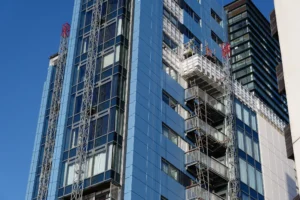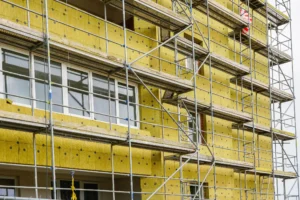As the façades and cladding industry experiences rapid growth, it faces an equally rapid rise in demand for skilled professionals. Regulatory reform, sustainability targets, and large-scale recladding programmes have pushed façades to the forefront of construction — but the available workforce hasn’t caught up. The result: a competitive talent market, rising salary pressures, and significant opportunity for those entering or developing within the field.
This article explores the key skill shortages shaping the sector in 2025 — and how employers and candidates can turn those challenges into opportunities.
1) A market transformed by regulation and demand
The façade industry has evolved faster in the past five years than in the previous two decades. Post-Grenfell regulations, the Building Safety Act, and net-zero design standards have redefined how façades are conceived, tested, and delivered.
At the same time, the UK’s recladding and retrofit programmes — plus new-build demand from commercial, residential, and healthcare projects — have created a pipeline that’s outpacing the available talent.
The challenge isn’t finding work — it’s finding qualified people to do it.
2) The biggest skill shortages right now
🔥 Fire and Compliance Specialists
Perhaps the most acute shortage lies in professionals who can interpret and apply building safety legislation.
Demand is high for:
-
Fire engineers and consultants
-
Building control surveyors
-
Gateway compliance coordinators
-
Quality and assurance managers
These roles are vital for the “Golden Thread” of documentation — and professionals with both technical and regulatory literacy are commanding premium salaries.
🧱 Façade Engineers and Designers
As the complexity of façade systems increases, so does the need for engineers who understand structure, materials, and thermal performance. There’s particularly strong demand for:
-
Curtain wall and rainscreen specialists
-
Structural analysts familiar with EN and CWCT standards
-
Façade design managers with coordination and BIM experience
Graduates and mid-level engineers with cross-disciplinary exposure (e.g. mechanical, civil, or sustainability backgrounds) are being fast-tracked to fill the gap.
🏗️ Installation and Site Management
On-site experience is in short supply. Skilled installers, site supervisors, and project managers with proven façade delivery experience are scarce — especially those trained in fire-safe installation and live recladding environments.
Many firms are now developing in-house training programmes to upskill site teams and subcontractors.
📊 Digital and Data Professionals
As façade compliance moves online, there’s growing need for BIM coordinators, document controllers, and digital record managers capable of maintaining the “Golden Thread” of evidence required under new regulations.
Data accuracy and traceability are now legal as well as technical priorities.
3) Why the shortages exist
Several structural issues explain the current supply-demand imbalance:
-
A limited education pipeline — Few UK universities offer dedicated façade engineering programmes.
-
Post-Brexit labour shifts — Reduced availability of skilled European labour has hit fabrication and installation roles hard.
-
Regulatory acceleration — The pace of change in fire safety and building control has outstripped the speed of training and certification.
-
Project clustering — Demand is concentrated in London, the South East, and major cities, causing regional shortages elsewhere.
These factors make strategic workforce planning — and proactive recruitment — essential for employers aiming to deliver safely and on schedule.
4) How employers can respond
🧭 1. Build training and mentoring pipelines
Create internal programmes that develop junior engineers and installers into competent façade professionals. Partner with technical institutions and universities to co-develop curriculum and apprenticeships.
🤝 2. Collaborate with specialist recruiters
Generalist agencies often miss the nuance of façade skillsets. Partnering with sector-focused recruiters like Green Carbon Partners ensures that job specifications are realistic, compliant, and aligned with market conditions.
💡 3. Offer flexibility and career clarity
Work-life balance, hybrid options, and transparent career progression are decisive in attracting and retaining talent — especially younger professionals.
💷 4. Benchmark salaries and reward competence
The façade sector is highly competitive. Pay transparency and structured development reviews help retain staff and avoid inflationary “jumping” between employers.
🌍 5. Invest in diversity and inclusion
Attracting more women and underrepresented groups into façade engineering and construction broadens the talent pool and strengthens team culture.
5) Opportunities for professionals entering the field
For candidates, skills shortages mean strong career prospects. Whether you’re transitioning from a related discipline or starting out, there’s a clear growth trajectory.
High-opportunity entry points include:
-
Graduate or trainee façade engineer roles (with mentorship on design standards)
-
Assistant project or site manager roles in recladding and retrofit projects
-
CAD/BIM technician positions in façade design offices
-
QA and document control roles supporting compliance teams
Professionals with transferable experience — such as from M&E, structural, or renewable energy backgrounds — can transition quickly with the right training.
6) The outlook: an industry of opportunity
As façades become central to sustainability, safety, and energy efficiency, the sector is moving from niche to mainstream.
Analysts forecast that demand for qualified façade professionals will double by 2030, driven by:
-
Net-zero retrofit programmes
-
Global fire safety reforms
-
New material and design technologies
-
Increased public and private investment in building performance
For those entering the industry today, façades represent one of construction’s most future-proof and purpose-driven career paths.
🌱 Green Carbon Talent: Closing the Skills Gap
At Green Carbon Talent, we’re proud to support the façade industry’s growth by connecting highly skilled professionals with the projects that shape our safer, more sustainable skyline. Whether you’re scaling your delivery team or planning your next career move, we help bridge the gap between demand and capability — building the workforce that builds the future.


